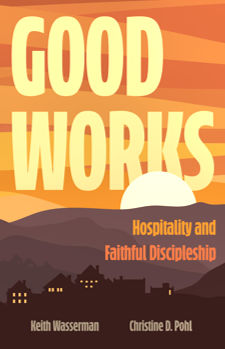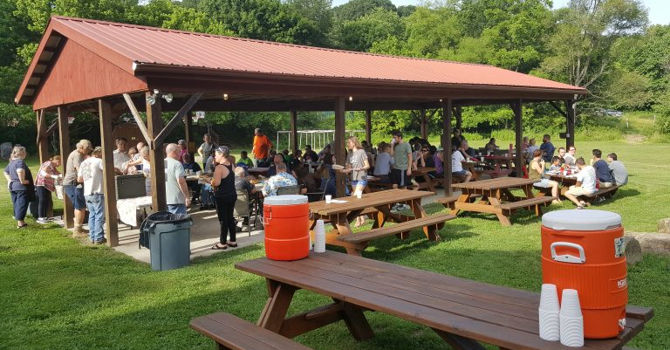Editor's note: Christine D. Pohl died June 5, 2023.
On New Year’s Day 1981, Keith Wasserman and his wife, Darlene, welcomed a woman named Carol into their home.
From that first gesture of hospitality has grown an extensive ministry called Good Works, which is focused on folks living in poverty and homelessness in the area around Athens, Ohio.
Healing, wholeness and friendship are the goal, and the offerings include a shelter, Friday night meals, gardens for fresh food, and a system by which people can earn points to buy things they need -- including cars.
In 1989, Wasserman audited an ethics class taught by Christine D. Pohl, now professor emerita of church in society at Asbury Theological Seminary.
She describes the ministry as a “demonstration plot” -- not, she says, because it’s perfect but because it is so deeply rooted in worship, respect, integrity, friendship and trust. It’s a dynamic that changes not just those living in poverty but everyone involved, from staff to volunteers to interns.
 Over the decades, the friendship between the practitioner and the scholar has deepened; Wasserman speaks to and meets with Pohl’s students, and Pohl has drawn from her experience with Good Works in writing her books about Christian hospitality, which include “Living Into Community” and “Making Room.”
Over the decades, the friendship between the practitioner and the scholar has deepened; Wasserman speaks to and meets with Pohl’s students, and Pohl has drawn from her experience with Good Works in writing her books about Christian hospitality, which include “Living Into Community” and “Making Room.”
The pair has now co-written “Good Works: Hospitality and Faithful Discipleship,” which explores the ministry’s core concepts and practices in the hope that others might learn from it.
Wasserman and Pohl spoke to Faith & Leadership’s Sally Hicks about Good Works and about how their long friendship has influenced their work. The following is an edited transcript.
Faith & Leadership: Christine, you’re the theorist and Keith is the practitioner, broadly speaking. What makes this particular ministry such an exemplar?
 CP: There is a way in which they really are a witness to the world, and I have loved that. I think it’s partly that there’s this combination of care and respect that you don’t always see in helping ministries -- that the respect piece is such a fundamental aspect of what Good Works is.
CP: There is a way in which they really are a witness to the world, and I have loved that. I think it’s partly that there’s this combination of care and respect that you don’t always see in helping ministries -- that the respect piece is such a fundamental aspect of what Good Works is.
Another is that for all these years, they’ve done it in community. Good Works is a community, and they welcome people into community, so it’s this long-term project of giving or offering to people a place to belong.
It’s not just a one-off kind of helping and solving a crisis; it’s actually welcoming people into a community and inviting them to be transformed, the commitment to move people from being recipients to participants.
That’s a huge thing in a hospitality tradition: that people don’t stay guests forever but they actually have a chance to change their identity. Here, the guests become participants. They become helpers. They participate, giving the good works toward other people. That’s a huge thing.
F&L: Keith, I’ll ask you the parallel question, which is, in what ways has your leadership and your ministry benefited from this engagement with a theologian, a scholar, in a university setting?
 KW: The language of hospitality was not something that I had or practiced, and you’ll notice in the book “Making Room” that Christine and I were having this conversation and I never attached “hospitality” to most of what we were doing.
KW: The language of hospitality was not something that I had or practiced, and you’ll notice in the book “Making Room” that Christine and I were having this conversation and I never attached “hospitality” to most of what we were doing.
Language has been significant in helping us see what we’re doing and find words and concepts that describe the practices to ourselves.
Then the second would be paradigm. I think that hospitality at some point became a paradigm, the way in which we were funneling a lot of our thinking around the mission and ministry and care for persons.
We try to find language that dignifies people, but the language of hospitality and the paradigm of hospitality actually became something far longer-term than I had originally thought it was going to be. Here we are 30 years later, and we’re still using the language.
F&L: Keith, at times you have gone to different places to experience homelessness yourself. How does that inform your work?
KW: My most recent experience was in Columbus, Ohio, and then before that, Louisville, Kentucky. There’s just so much in these stories that has directly changed or influenced the way we operate.
I recommend this to anyone that is caring for people or learning to love people who have been violated or who have trauma. You and I, we need to experience on some level what it’s like to be in the recipients’ story.
I don’t think you need to stay overnight in a shelter, but there is a lot people can do to go incognito for a few hours just to see what it’s like from a “one of them” perspective.
[For example] the boss comes in and pays me for my morning work stripping tobacco. He pays me in front of everybody. It’s at that moment that I realize you can’t save money and stay on the streets. People will either borrow it, or they will “borrow” it.
I took it like everyone else and spent it immediately on my drug of choice, which was a hamburger, french fries and an iced tea.
Those little snapshots have helped me see in some ways how people live for today, how the concept of saving is in some ways a middle-class value. It helps me have perspective on our structure.
F&L: Christine, you’re in a different position. What have you learned over the years being part of this project? What have your students learned?
CP: I have not spent time on the street, but for me, friendship across differences has been really significant. You become close enough friends with people who are struggling that you actually begin to see it through their eyes. That has been really important.
Keith’s stories, the stories of Keith being on the streets, were always extremely impactful for students and for me. You can learn some of that secondhand. It’s not quite as visceral and significant, but it’s a good step into some of those issues.
KW: One of the themes of living in these different shelters over all these years is the growing awareness of how dehumanization in the culture is becoming institutionalized.
Somehow, people justify acts of dehumanization and don’t even think of how impacting it is to keep somebody in that identity of vulnerability and poverty. I’ll give you two snapshots.
The first is when I was in Columbus. I was waiting around, and they had sent everybody up to their rooms, and then they were going to call them back down. And they called them back down by number. I don’t think they understood how dehumanizing this was.
They would say, “No. 43, we need you to come downstairs.” And, “No. 62, we need to talk to you.” I don’t think anyone thought differently of it, maybe not even the residents. It’s a prison culture, and oftentimes there’s a thin line between how shelters operate and how prisons operate.
Then another snapshot came in Louisville, Kentucky, when I was staying overnight in a room. There were probably 50 men in this shelter, and it was dark, and one of the guys was talking out loud to himself, and he was irritating everyone. People would yell at him from different parts of the rooms, and that didn’t make any difference.
Finally, somebody went out and called the staff, and the staff came in, and it was obvious to me -- my background is in the field of mental health -- that they didn’t have any training in de-escalating. So they intimidated him, used foul language, raised their voices and made threats in order to force him to stop talking.
I found that to be a snapshot into the dehumanization process that is so rampant. So when I go to the streets and I experience that, it helps me kind of cleanse the lenses in my glasses to make sure that I’m looking for ways that we are unintentionally dehumanizing.
I found this phenomenon of dehumanization -- it’s in the broader culture, but it’s particularly focused on people who are very vulnerable that institutions need to control.
F&L: As you look at the work, do you see yourself as making systemic changes, or are you more focused on serving individuals?
KW: Well, we look at the work that we do through the vision of worship, so we’re not results oriented. It’s very difficult to measure the change in people or structures, although we do see glimpses of it.
In an average year, we’ll have 25 to 35 groups that will come visit Good Works and stay for a week or a weekend. As I interview them about why they come back, oftentimes they’ll tell us that the impact of their visit has transformed the way they do mission in their own communities.
That’s encouraging, but that’s not exactly what we’re aiming for. I think we’re aiming -- I don’t know how this will sound -- we’re aiming to be worshippers ourselves.
I look at John 4 and see that the Father seeks worshippers who worship “in spirit and in truth” (John 4:23). So I want us to do work that is full of worship. Whether we’re serving a meal or cleaning a toilet or just listening, I want us to grow into being worshippers.
F&L: You define worship in the book, and then you talk about the ways in which you live into that. Explain a little bit.
CP: Worship is both intimacy with God -- it’s praise and thanksgiving and admiration, but that can never stand alone. It has to also be lived out in our everyday relations with other people and our concerns for justice and for mercy and respect and so on.
I think one of the things Good Works has been able to do is to demonstrate to people that there is a way of living in which our whole person is involved in worshipping God, as we’re loving our neighbors, as we’re responding to a need, and so on.
F&L: What does worship look like at Good Works?
KW: Well, of course we do gather for song and teaching, and that aspect is pretty consistent with the way the church functions.
But we go out and serve at the homes of widows and widowers and those struggling with a disability. We’ll bring shovels and rakes and lawn mowers and chain saws. Those become the instruments of our worship.
I like this phrase, “Lord, this is for you.” Forcing ourselves to live on a higher level.
I do think that worship has become very narrow in its religious definition, when actually it’s so broad that everything we do, the way we sequence our words, the choice of words, the tone we use is an act of worship. I think that even listening is an act of worship. “Lord, this is for you.”
F&L: You argue in the beginning of the book that this is a particular context but that the model has broader application. What would be the essential features of your experience?
CP: Part of the reason I was excited about helping with the book was seeing the impact of some of Keith’s talks on my students. For me, it was the intense emphasis on integrity and building trust and respect as you offer care. That’s something that goes across all kinds of ministries.
It’s so rooted in integrity. The staff are always part of the work of human flourishing, in the sense that we’re all wanting to grow and be made whole. It’s not just for the sake of the recipients; it’s everybody.
KW: Four best practices come out of the Luke 4 passage “The Spirit of the Lord is on me; the Lord has anointed me to bring good news to the poor” (Luke 4:18).
We ask some questions that give rise to the four practices, and the questions are, first, who are the people in our context that are struggling with poverty, starting with their names?
Then, what is it that they particularly struggle with in our context? Some of that is universal, based on poverty; some of it is U.S. Western poverty.
Then, what is the gospel, and how do we bring it?
No. 1, it’s about relationship, not program. A lot of times, we’re tempted to talk about how much we can accomplish with resources, but ultimately, I think it’s about one at a time. I think the discipleship happens in a smaller context much better than it could ever happen in a bigger one. That’s my bias.
No. 2, it’s about trust. We ask, “How will these words or these decisions or these actions or these behaviors build trust, and how might they diminish trust?” Even the words “the poor,” if used in the wrong context, can really diminish trust, just as an example.
No. 3, it’s about meeting a need or a felt need. There are many needs to be met. But one of the more significant things I have come to understand is -- and this is true across the board, wherever you go -- meeting the need to be needed.
And No. 4, is there a way for those who start out on the receiving side to become participants, where they have an identity change?
I’ll give you an illustration. We provide cars and furniture and appliances to people from rural Appalachia in Athens County. We just provided car No. 186 in March.
So when someone calls us and they say, “I heard I could get a car,” I like our staff to say, “Well, you called the right place at the right time, and we’re glad you called.”
The purpose here is to take them through a journey of an identity change, where they leave the old identity eventually of “needy” and enter into a new identity.
We found language in our culture that gives people a new identity. It’s called “volunteer.” We invite them to volunteer their time. In exchange for their time, they get points. In exchange for their points, they can get a car or an appliance.
We clothe them with dignity, we invite them into community, and then we invite them to use their abilities to help others. And in doing so, something transformational happens in their lives -- and, because of the vision of mutuality, in our lives as well.
















